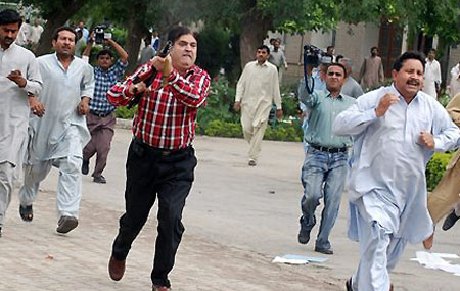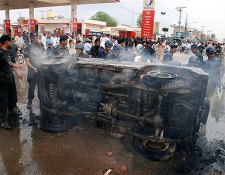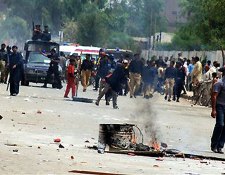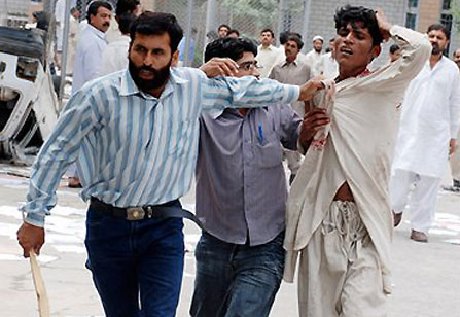Adil Najam
These pictures from the Associated Press are truly astounding (story in Dawn).
Crowds rioted in Multan – the home city of the new Prime Minister Yousuf Raza Gillani – in protest of the massive power cuts because of the growing energy crisis in Pakistan. The office of the Water and Power Development Authority (WAPDA) were ransacked. A dozen cars and buses were set afire. Stones were thrown. A bank was torched. At least 13 people were injured.
The angry man with the gun in the red shirt that you see in the first picture is senior WAPDA official, Mohammad Ishtiaq, opening areal (hawaii) fire to disperse the crowd after about 10 WAPDA workers were injured. In the last picture you see an unidentified WAPDA official grabbing hold of one of the protesters.
This is the “power” politics at its very worst. The real face of energy insecurity. When life is made miserable, anger spills on the streets and so does blood. The senselessness of the violence is only compounded by the senselessness of the energy crisis that triggered the violence. And it is not even summer yet. It promises to be a summer of even greater discontent.























































The support of violence as a tool is itself part of the problem. The tragedy is that decent people can fully understand both the point of view of the protesters and also of the WAPDA staff who started shooting. The fact that things got so bad that both had to resort to violence shows how dangerous things are and why thsi has to become the top most priority.
The hot season is almost upon Pakistan, and Multan is one of the hottest big cities. People are facing a summer of sitting in their homes and businesses without air conditioners. In addition they are losing money because of the impacts on their businesses. Of course they’re angry.
Power needs to be saved, and a huge source of waste in Multan is air conditioners. The traditional architecture of the region in the past accomodated the need for air flow and cool rooms. Look at the old houses–granted they are dark and feature very thick walls. But they are cool, or at least bearable. If you have uninsulated walls and big plate glass windows, you will need artificial cooling.
Regardless of how this energy crisis works out, people cannot waste power on things like personal air conditioning any more. This is true for every country. Energy should be spent on manufacturing and lighting and other definite needs. Architecture should take on the challenge of designing buildings for work and living that use less power for cooling.
That would be a start. There are a lot of other things as well.
Why should they remain calm? They have no reason to stay calm. Things are at life and death levels now and people have nothing to lose.
People sitting in their air conditioned rooms eating their parathas are always quick to call for calm. The only way to get attention and to get things done is to protest. Protest in such a way that the fat cats in the government have NO CHOICE but to make this emergency a PRIORITY.
Pakistan has always had the resources, both natural resources and human talent, to be one of the BEST countries in the world but people are using OUR resources for personal gain.
I say it is good to protest. With out it nothing will get done. Put the pressure up on the fat cats. It’s the only way.
The fact that Mohd. Ishtiaq of WAPDA had to take things in his own hands and start firing and the other official is seen nabbing protesters themselves raises too many questions. I can see how they are forced to do so but really disturbed that society has broken down to a level where this has to happen.
What I was struck by was PM Gilani’s reaction to the event – although he called for restraint, he said the government would address the problem “on a priority basis.” I know the government is pretty overloaded with issues they have promised to address – the restoration of the judiciary, the lifting of media censorship, the security issue – but the food and power crises is imminent for the people of Pakistan, it is something that is affecting their daily life – those problems are the issues that lead to violence, that allow for easy recruitment by militant groups. The question is, when DOES it become a priority?
I also wrote about the power riots in Multan yesterday (www.changinguppakistan.com), and probed similar questions.